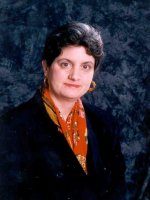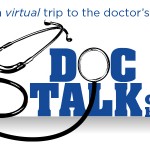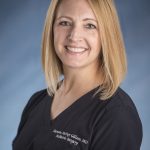 By Shannon Magsam
By Shannon Magsam
Since this is the last week of National Breast Cancer Awareness Month, we wanted to share life-saving information with you from Donna Johnson, a surgeon with Mercy Health System’s Surgical Center and mother of three.
Dr. Johnson is a general surgeon, but about 40 percent of the surgeries she performs are breast-related. She moved to Northwest Arkansas nine years ago when she was pregnant with her youngest child (and thought she was going through menopause). She made the move from trauma and general surgery at UAMS in Little Rock because she wanted one-on-one interaction with patients, many of whom are struggling with breast cancer.
Here are the highlights of our conversation about the disease:
The good news: Women are much more tuned in to their bodies than even their own mothers were, so they notice abnormalities more often. And when they detect something that warrants concern, most of the biopsies are benign (not cancerous), Dr. Johnson said. But even when the news is cancer, the good news is that if it’s caught early, over 90 percent are curable.
Breast practices: You can’t detect anything unusual if you don’t get in the habit of performing self breast exams. Dr. Johnson reminds us to do what we all know we should be doing, but don’t always take the time to do. She recommends starting in your late teens and early 20s. The best time to do self breast exams is right after your period. She said fibrocystic changes during your period can skew your results. “Things that come and go are typically not anything to worry about,” she said. “If something comes and stays, it warrants attention.” Typically, she said, cancer is not painful, though there are a few exceptions. She recommended cutting out caffeine and taking Oil of Evening Primrose pills for those who have painful fibrocystic breasts.
The yearly appointment we all love to hate: Even with self breast exams, it’s important for a medical professional to also perform breast exams every year (and do the dreaded pap smear), Dr. Johnson stressed. And she encourages you to listen to your own body. She recalls one patient who knew her breast felt “different” though nothing unusual could be identified on a mammogram or ultrasound. However, the patient continued to push for further testing and she did, indeed, have breast cancer. The woman is doing well now, in particular because it was found early, Dr. Johnson said.
Risk factors: Of course, family history is the most important indicator. Breast screening should be done early if there is a history of pre-menopausal breast cancer in your family (Dr. Johnson says it’s not the same risk if your mom, for example, had it at age 60 or above). Other factors: Starting your period at age 10 or younger; menopause after 50 (which Dr. Johnson says is late, which rocked my world. I thought I wouldn’t start having to worry about menopause until I was well into my 50s. Yikes!); and delaying childbirth until after age 35.
Mammogram anyone? Dr. Johnson said it’s best to get a baseline mammogram in your mid- to late-30s so that when you get that first official one at age 40 you’ll know if anything changed. Of course, those with a history of breast cancer in their family should begin much earlier. Women should officially start getting mammograms every year after age 40. She said the breast is usually so dense until after age 35 that it’s more difficult to detect abnormalities. Ultrasound and MRI’s are being used more and more to detect abnormalities, she added.
Is there more incidence of breast cancer now? Dr. Johnson said various theories abound, but in general it’s believed that there is more “lead time bias” now, meaning the disease was caught early. She said women are delaying childbirth, which slightly increases their risk. She said the incidence of breast cancer was one in10 women when she first started practicing medicine 20 years ago. Today, it’s one in every eight women. Dr. Johnson said breast cancer risk increases as we age, but things like diet and obesity can predispose women to the disease.
Dr. Johnson noted that women need to avoid smoking, maintain a healthy body weight and eat healthy food, especially a diet high in antioxidants (berries, tomatoes, broccoli, garlic, spinach, tea, red grapes, carrots, soy, whole grains) to decrease chances of malignant cancers.
New treatments: “The treatment has evolved from radical mastectomy – cutting out muscles and lymph nodes – to less radical surgical treatments,” Dr. Johnson said. She said with the cancer being detected early, chemo can start early and shrink the cancer which makes surgery less radical.
There are also new chemotherapy options for women at risk of re-occurrence. “There is new testing that can be done, so we can tailor treatment a little more closely,” Dr. Johnson said. It also can take less time to treat. “Radiation can now be given directly into the breast over a period of less than a week as opposed to the usual six-week regiment,” she said.
Also, the methods of controlling treatment side effects are much improved.
Genetic testing is also being used more and more to ascertain a woman’s risk. They can detect genes that predispose women to breast cancer, Dr. Johnson said. Some women opt to have bilateral (both sides) mastectomies to reduce their risk. She said reconstruction has vastly improved.
The bottom line is to get it checked out if you detect an abnormality. The earlier the better.
“The fear is that breast cancer is a death sentence and it’s not,” Dr. Johnson said.






WOW! WHAT A GREAT ARTICLE ON BREAST CANCER. I LEARNED A LOT THANKS TO YOUR INTERVIEW WITH DR. JOHNSON.
KEEP UP THE GREAT INTERVIEWS. THEY ARE VERY INFORMATIVE.
LOVE YOUR WEBSITE!